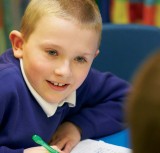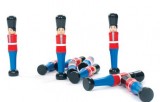Richard McFarn pins down the elusive secret to pleasing the Ofsted inspector...
Why are we fixated on the word outstanding? Simple answer: Ofsted. Over the last five years, Ofsted and school observations have made us increasingly obsessive about teaching outstanding lessons. The problem is that until very recently, inspectors have, to an extent, kept what they are looking for a secret. When asked what an outstanding lesson looked like, one inspector is quoted as saying, ‘You’ll know it when you see it!’ Another said, ‘It’s kind of hard to put into words.’ Ofsted criteria is vague and often misinterpreted by SLTs. All of this makes it incredibly difficult for us to know what outstanding history is. But don’t be too disheartened.
When it comes to history teaching is schools, there is a lot to celebrate. A recent Ofsted report entitled, Improving Primary Teachers Subject Knowledge Across the Curriculum (excluding English and Maths) stated that, ‘the quality of history teaching was higher than all other subjects in the survey.’ Teachers enjoy teaching history. However, the report did highlight a problem. Namely, ‘that teachers’ emphasis on imparting historical knowledge to pupils failed to take account of the specific skills that young historians needed to employ, such as using and evaluating evidence.’
To my mind, this touches on the main barrier to teaching outstanding history: we don’t know what we don’t know. What I mean by that is we think we know what history is - the fixed story of the past. So we tell this story, or we ask children to go and investigate and find the answers for us. But this isn’t good history. History isn’t just lots of information about battles, toys, the seaside, Florence Nightingale and dates…and dates. Don’t get me wrong, knowledge is important. But history is more than regurgitated knowledge. And we shouldn’t always do the telling.
To illustrate this point, on the next page I’ve included three stages to teaching outstanding history.
 What actually is history?
What actually is history?
In simple terms, history is a discipline. How does history work? Below it’s brilliantly summarised by Neil Thompson, history consultant and founder of the website keystagehistory.co.uk.
• Firstly, history is the process of enquiry, the search for evidence, the examination of this evidence by sorting, evaluating and weighing it.
• Secondly, historians use this evidence to imaginatively reconstruct the past – to write their history. The problem is that evidence is nearly always incomplete.
• So, thirdly, historians use their skills to fill in the gaps and imagine and infer how it might have been. When historians describe and explain the past, what we get is their construct, and not a fixed and uncontested view of the past. It is the three stages of this process that we need to get across to our children at different points in the curriculum over six years.
 What approach might we take?
What approach might we take?
We all know a cracking teaching idea when we see one. However, the answer to outstanding history is more than one great activity. Instead we should knit together tasks to form a coherent, fun yet rigorous enquiry (‘inquiry’ actually means history in ancient Greek). The children need to inquire or investigate for themselves. We need to facilitate this and make them think. Sending children off to the computers to research Henry VIII doesn’t always give the best results. So what is the answer? Working with colleagues in Hampshire a few years ago, we came up with our own ‘vital ingredients’ for good historical enquiry:
1. Students should genuinely investigate for themselves, maybe in role.
2. There is an element of the enquiry being contentious.
3. They use authentic sources /evidence – even if in modified form.
4. There is a coherence to the way the enquiry progresses.
5. The enquiry must promote an aspect of the historical process.
6. The guiding problematic enquiry question is referred to frequently in each lesson.
7. There must always be an element of students working on their own ideas.
8. There should be some new injection of evidence or information, to simulate the reality of historical research and to encourage students to react to it. This should deepen their understanding of the issue or topic.
9. Students arrive at an independent conclusion, forming their own judgment. This should be an end product which commits students to creating an answer. Great theory, but what might what this look like in practice?
 A favorite task in y1 asks the children to bring in toys, before going on to look at the differences between old and new toys. great task – but how do we make this activity an outstanding enquiry that includes the ‘vital ingredients’ mentioned in stage 2?
A favorite task in y1 asks the children to bring in toys, before going on to look at the differences between old and new toys. great task – but how do we make this activity an outstanding enquiry that includes the ‘vital ingredients’ mentioned in stage 2?
• Start with the problem and place the children in the role of expert - The local museum is about to put on an exhibition called A History of Toys. The problem is the clumsy curator has lost all of the labels – can the class help him? (1,2 and 4)
• Handling the evidence – Take two teddy bears, ask the children to describe which one is new and which is old. Get them to justify their views by using the appropriate language –‘it’s torn’ ‘faded’ ‘bright’. Model the language. This establishes the difference between ‘new’ and ‘old’. (3,4,5 and 7)
• Sorting and classifying the evidence – Next play the ‘odd one out’ to cement ‘old’ and ‘new’ in a different context and model the process. Introduce three toys, maybe three trains or dolls and ask them to work out which one is old (and therefore the odd one out) and which two are new. Again stress appropriate language. They might disagree but that’s fine. It’s the thinking that counts. Now introduce a big box of toys. The next job is to sort them into old and new. You can then stretch the activity by asking the children to sort them in different ways – wood and plastic, toy types etc. The more sorting and classifying and evaluating we do the better as this kind of thinking is vital to future success. (4 and 7)
• Taking it a stage further – Now introduce a new twist, to deepen the understanding. Introduce three or four characters, photos of children from different times: Victorian, 1950s, 1980s and today. Can they sort the photos into chronological order? And can they work out which toy belonged to which person? (4 and 7)
• The final twist - Pick up the phone and sound disappointed into the receiver. Tell them you have just heard there isn’t enough space for all of the toys at the exhibition. There is only space for four! Which four will the class choose? Which toy is best for the person and best to represent that time? This takes their thinking even deeper. (4 and 8)
• The end task – The children could draw and label the toys they would choose and justify their choice to you. It really doesn’t matter if they disagree – after all historians disagree about the past all of the time! (4 and 9).
Richard McFahn is a former History AST and now Humanities Adviser in West Sussex
5 Ways To Celebrate World Book Day
Ace-Classroom-Support
8 Ways To Get Your Class Drawing
Ace-Art-And-Design
